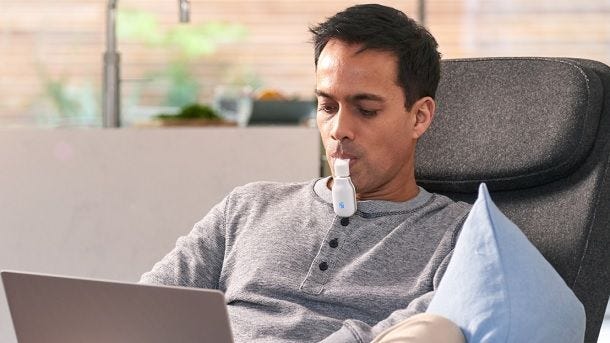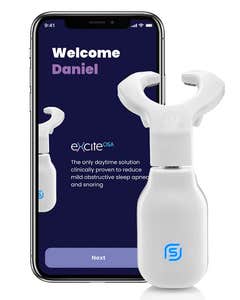Pros and Cons of Using Oral Appliances for Sleep Apnea
This post was originally posted on December 10, 2021, and updated on June 21, 2022.
Sleep apnea continues to be one of the most prevalent sleep disorders, affecting over 22 million Americans. Because symptoms of sleep apnea like loud snoring are often overlooked, the sleep disorder is a condition that typically goes undiagnosed.
The good news is that with a diagnosis, effective treatment is available. The most common treatment for obstructive sleep apnea (OSA) using a CPAP machine. However, other options are available depending on patient needs. Oral appliances may also be helpful in curbing sleep apnea symptoms. Take time to review all the options with your doctor after you have received an obstructive sleep apnea diagnosis.
What is Sleep Apnea?
Sleep apnea is a sleep disorder in which a person's breathing starts and stops frequently while they are sleeping at night. This condition is caused by a narrow airway, making it harder to breathe. Muscles in the throat tend to relax or collapse which blocks the airway and prevents oxygen from getting into the body. The lack of oxygen will make a person wake up and gasp for air. In severe cases, the episode of not breathing, also known as apneas, could occur 30 times within one hour, disrupting sleep and resulting in negative side effects to a person's overall health and well-being. Long-term sleep apnea leaves most patients sleep-deprived, which causes lasting health issues.
Left untreated, obstructive sleep apnea has a number of associated short- and long-term health risks including cardiovascular disease, diabetes, high blood pressure, and mental health issues such as anxiety and depression.
What Are the Treatments for Sleep Apnea?
CPAP Therapy
The most common treatment for sleep apnea is CPAP therapy. A sleep apnea patient uses a CPAP machine to blow pressurized air into their airway to prevent it from closing at night. The continuous airflow at a setting prescribed by a doctor ensures uninterrupted sleep by preventing the disruptive apneas. As a result, patients will experience better sleep and better health.
CPAP therapy must be conducted nightly, and patients must be CPAP compliant to see any progress in the treatment. Adjustments to therapy are usually made throughout the course of the treatment to make the patient more comfortable while still adhering to effective air pressure settings.
Oral Appliances
For patients with mild to moderate sleep apnea, an oral appliance is an alternative treatment. Oral appliances prevent the tongue from blocking the throat. Wear this type of device daily to help prevent apneas without a CPAP machine.
There are two types of oral appliances:
- Mandibular Advancement Devices (MADs) open the airway by moving the mandible (the lower jaw) forward.
- Tongue Retaining Devices (TRDs) also work by holding the tongue in a forward position. These devices pull the tongue forward, but instead of moving the jaw forward like a Mandibular Advancement Device (MAD), TRDs directly control the tongue itself.
Surgery
For the most severe cases of sleep apnea, surgery may be required. Surgeons may follow a number of strategies to treat the problem including shrinking tissues in the back of the throat to help keep the airway open or possibly removing excess tissue in the airway that may be causing the apneas.
Additionally, in some instances, surgeons may reposition the jaw to maintain alignment in the airway or tighten the tendons in the tongue.
Most sleep apnea surgery is selected after other non-invasive treatments have failed. Most doctors will recommend CPAP therapy and oral appliances before recommending surgery as an option.
How Do Oral Appliances Work with Sleep Apnea Treatment?
Oral appliances of both types position areas of the mouth to ensure that the airway stays open. Doctors and even dentists may be involved in developing and applying oral appliances. Worn regularly, the devices adjust the position of the jaw or tongue so that airways remain open all night without disruption.
However, many patients will experiment with CPAP therapy and oral appliances and in some instances may choose both for combined therapy. CPAP machines can be difficult to get used to for many new patients of the therapy and they may switch to oral appliances as an alternative. But there are both pros and cons to oral appliances.
Pros of Using Oral Appliances for Sleep Apnea
- Oral appliances are less clumsy than CPAP machines. There are no wires or masks, which simplifies the process for sleep apnea patients
- Any oral appliance is small and compact and easy to take anywhere. Sleep apnea patients can easily continue using their oral appliances on business trips and vacations
- Many of the side effects of CPAP therapy may not occur by using an oral appliance. Dry mouth, sore throat, and nose irritation are just some of the side effects of CPAP therapy patients may encounter. Many patients who tried CPAP therapy and experienced symptoms or difficulty with the therapy vied for the appliance instead.
Cons of Using Oral Appliances for Sleep Apnea
- Patients using this type of device may experience other side effects such as jaw pain, soreness, or stiffness
- As the jaw shifts from using the appliance, patients may feel lingering pain in their teeth and gums
- Oral appliances stimulate the salivary glands, leading to excessive saliva production, which can be inconvenient and uncomfortable
- If a patient using an oral appliance has crowns or bridges, those dental additions may be loosened by the repositioning of the jaw caused by the appliance
- In some instances, the repositioning of the jaw becomes permanent which can lead to chronic pain or discomfort even when the oral appliance is not being used
Oral Appliance for Sleep Apnea
If after discussing options with your doctor you choose to try an oral appliance, you can use the eXciteoSA Daytime Therapy for Mild Sleep Apnea.
eXciteOSA® targets the root cause of mild OSA and snoring rather than relieving the symptoms. Focusing on the tongue's muscle function, eXciteOSA also provides stimulation therapy to strengthen the muscles and prevent the airway tissue from collapsing and causing apneas. Fewer apneas mean better sleep.
- This device is for the treatment of mild to moderate sleep apnea
- The device can be used during the daytime for about 20 minutes
Where Can I Buy Oral Appliances for Sleep Apnea?
You can find oral appliances for sleep apnea at The CPAP Shop. Our helpful staff can assist you with your purchase. Call 866-414-9700 to learn more.





